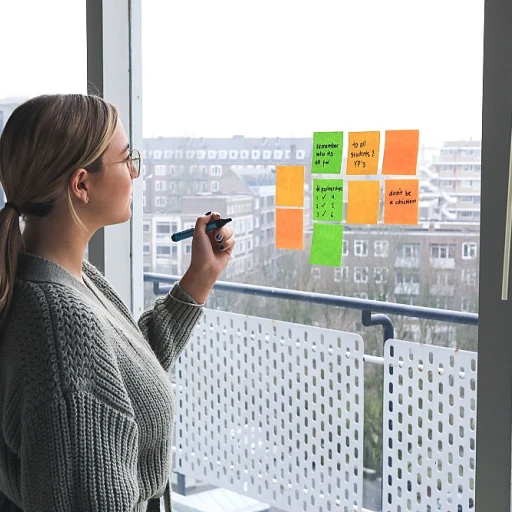The Role of Technology in Employee Experience
Technology's Impact on Employee Engagement
In today's rapidly evolving workplace, technology plays a pivotal role in shaping the employee experience. With the advent of digital tools, companies are finding new ways to engage their workforce, streamline processes, and enhance overall productivity. The integration of technology into the employee experience is not just about providing the latest gadgets or software; it's about creating a seamless and supportive environment that fosters engagement and satisfaction.
One of the key aspects of leveraging technology for employee experience is the use of digital platforms that transform how employees interact with their work and each other. These platforms, which will be explored further in subsequent sections, are designed to facilitate communication, collaboration, and access to resources, thereby improving the daily work life of employees.
Moreover, companies are increasingly adopting a strategic approach to employee experience, recognizing that technology is a crucial component of this strategy. By aligning technological solutions with organizational goals, businesses can create a more cohesive and supportive work environment. For a deeper dive into enhancing the digital experience for employees, you can explore more insights here.
As we delve into the various facets of employee experience technology, it becomes evident that measuring success through data and insights is essential. This will be discussed in more detail in later sections, where we will also address the challenges companies face in implementing these digital solutions.
Embracing Digital Tools for a Collaborative Environment
The digital transformation of the workplace isn't just about adopting the latest technology—it's about creating a collaborative environment where employees are empowered to connect, communicate, and collaborate seamlessly. This transformation underlines how crucial digital platforms are in enhancing the employee experience, serving as the backbone for fostering a cohesive and productive work culture.
The integration of team collaboration tools like Slack and Microsoft Teams play a pivotal role in this transition. These platforms not only facilitate real-time communication but also integrate with a myriad of applications that simplify workflow management. By breaking down organizational silos, these tools encourage cross-departmental collaboration, paving the way for innovative solutions and increased agility.
Moreover, digital productivity suites such as Google Workspace and Microsoft 365 offer employees the flexibility to work from anywhere, anytime. This adaptability is vital in today's fast-paced work environment, especially in light of recent shifts towards flexible working arrangements and remote workplaces. For companies investing in enhancing the digital experience for employees, the focus is on streamlining processes and eliminating friction points that hinder productivity.
One cannot overlook the rise of project management platforms like Asana, Trello, and Monday.com, which have revolutionized how tasks and projects are tracked. These platforms have made it easier for teams to manage workflows and keep track of progress, ensuring transparency and accountability at every stage of a project.
The use of digital platforms in transforming the workplace is a testament to their importance in supporting a positive employee experience. As organizations continue to navigate the digital age, the strategic deployment of these tools will be integral to boosting employee engagement and fostering a dynamic work environment. As explored in other sections, a robust employee experience strategy should incorporate these technological advancements to drive engagement and productivity, while understanding the challenges and future trends will ensure their successful implementation.
Employee Experience Strategy: A Company Perspective
Integrating Technology for Actionable Employee Experience Insights
In today's rapidly evolving workplace, developing a comprehensive strategy for employee experience is not just an option—it's a necessity. Companies are increasingly turning to innovative technologies to enhance the well-being and productivity of their workforce. By aligning digital tools with a carefully crafted employee experience strategy, organizations can create more tailored and meaningful engagement initiatives.
A well-defined employee experience strategy should have at its core a clear vision of company values and objectives. This foundation enables businesses to utilize emerging technologies effectively, ensuring that their integration truly benefits the employees. As emphasized in previous discussions about the role of technology, the adoption of digital platforms can significantly contribute to an optimal working environment.
To develop a robust strategy, companies need to focus on harnessing technology in ways that resonate with their workforce. This involves engaging with employees to understand their unique challenges and preferences. For example, by leveraging data analytics and feedback mechanisms, organizations can gain important insights into employee needs and behaviors. These insights allow businesses to make informed decisions and tailor their digital solutions accordingly.
Moreover, effective strategies should also account for the diversity of roles and geographical locations within the company. For remote teams, specific considerations must be taken to ensure they feel connected and supported. Enhancing remote employee experience can be achieved through digital platforms that facilitate seamless communication, collaboration, and resource accessibility.
Explore innovative approaches for remote work environments.
In conclusion, companies that succeed in crafting an employee experience strategy powered by technology are likely to see improved engagement, productivity, and retention. By evolving with technological advancements and continuously refining strategies to align with employee feedback, organizations can maintain their competitive edge in attracting and retaining top talent.
Measuring Success: Data and Insights
Quantifying Success in Digital Employee Experience
In the realm of enhancing employee interaction through digital means, assessing the outcomes becomes a crucial aspect. To truly understand the effectiveness of technological implementations, companies need robust methods to measure and analyze their success.
The evaluation begins with the utilization of various metrics that provide insights into both qualitative and quantitative aspects of employee engagement. These might include employee satisfaction surveys, usage statistics of digital tools, and performance indicators. By combining these data points, organizations can gain a comprehensive view of how well their digital initiatives are resonating with their workforce.
Moreover, data-driven insights play a pivotal role in refining and optimizing employee experience strategies. Regularly analyzing feedback and performance data enables organizations to identify areas for improvement and adapt their strategies accordingly. This iterative process not only helps in maintaining high levels of engagement but also ensures that the technology remains aligned with employees' ever-evolving needs.
In parallel with advanced analytics, organizations must also compare their progress against industry benchmarks. Evaluating their digital employee experience against peers provides an external perspective that can further guide strategic decisions.
Lastly, promoting a culture that values continuous feedback allows companies to remain agile in their approach. As explored in earlier discussions, the adoption of evolving digital platforms is essential. The feedback loop established through these evaluations supports the creation of a dynamic workplace that can swiftly adapt to new technological trends and challenges, ensuring a future-ready organization.
Challenges in Implementing Digital Employee Experience
Navigating the Digital Landscape: Overcoming Obstacles
While the integration of technology into the employee experience has ushered in numerous benefits, there are significant challenges that organizations often face during implementation. These hurdles, if not addressed timely and effectively, can hinder the potential for positive transformation in the workplace.
Firstly, there exists a common concern related to the resistance to change. Employees accustomed to traditional methods might find the transition to digital platforms daunting. Effective training programs and clear communication strategies are essential in easing this transition and ensuring that employees understand and embrace new technologies.
Compatibility and integration issues also pose substantial challenges. Organizations typically use a variety of systems and platforms, and ensuring these systems communicate effectively can be complex and costly. Seamless integration is critical to avoid disruptions in workflow and maintain productivity.
Data security and privacy concerns are also paramount. With increasing volumes of data being processed digitally, safeguarding sensitive information becomes crucial. Companies must establish robust security protocols to protect employee data and maintain trust.
Lastly, there is the financial aspect. Implementing state-of-the-art technology solutions requires significant investment. Organizations need to weigh the upfront costs against the long-term benefits, ensuring that return on investment is clear and justifiable.
Through strategic planning and by addressing these challenges proactively, companies can successfully harness technology to enhance the employee experience, as previously highlighted in our exploration of digital platforms transforming the workplace and strategizing from a company perspective.
Future Trends in Employee Experience Technology
Emerging Technologies and Their Impact on Employee Experience
As we look to the future of technology in enhancing employee experiences, certain advancements stand out as key players, each promising revolutionary changes in the workplace. Understanding these trends can equip organizations with the foresight and tools needed to stay ahead.
Artificial Intelligence (AI) continues to be a transformative force, offering personalized experiences and streamlining workflows. AI-powered analytics can provide deeper insights into employee engagement patterns, facilitating proactive support and tailored development programs. The integration of AI-driven applications within digital platforms, as previously mentioned in our breakdown of digital platforms transforming the workplace, can redefine task management and communication efficiency.
Virtual Reality (VR) and Augmented Reality (AR) are also paving the way for immersive experiences that promote learning and collaboration. These technologies eliminate geographical barriers by allowing employees to participate in virtual meetings and training sessions that feel incredibly lifelike, fostering a more connected workplace culture.
The Internet of Things (IoT) is expected to further personalize the work environment. IoT devices can enhance comfort and productivity through smart office setups that adjust lighting, climate, and ergonomics to individual preferences. This level of customization will be crucial in crafting a supportive workplace atmosphere.
Moreover, as organizations continue to adopt hybrid working models, cloud-based platforms are becoming indispensable. These platforms not only support seamless remote work but also play a vital role in fostering an inclusive culture—encouraging participation regardless of an employee's location.
Finally, blockchain technology's role in enhancing data security and privacy will become increasingly relevant as organizations seek to protect employee data and sensitive information. This added layer of security builds trust and ensures compliance with privacy regulations.
In navigating these emerging trends, as discussed in our exploration of challenges in implementing digital employee experiences, it is essential for companies to stay adaptive and forward-thinking. Embracing these technological innovations can set the stage for enriched, dynamic employee experiences that align with organizational goals and employee expectations.






